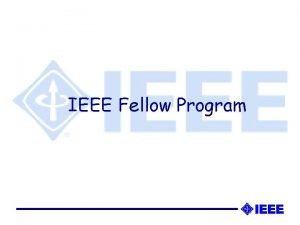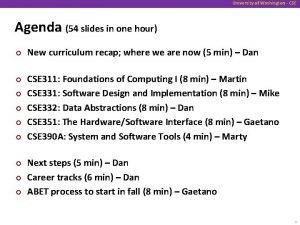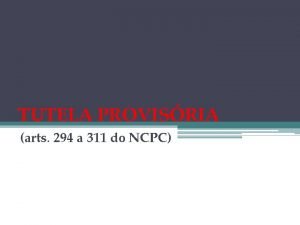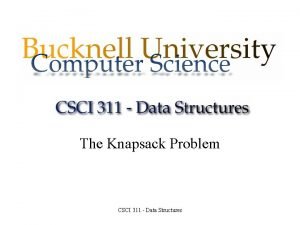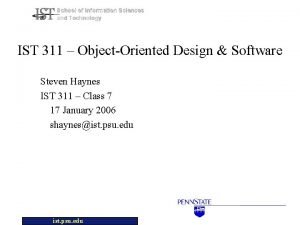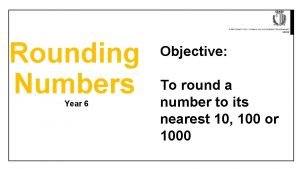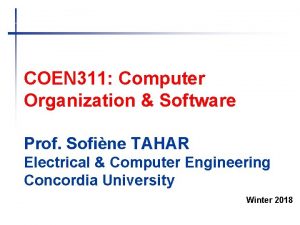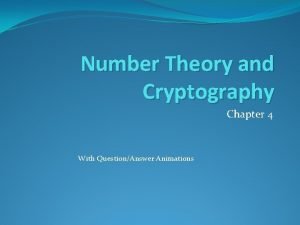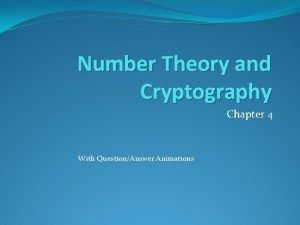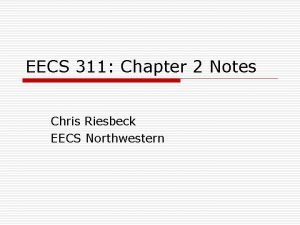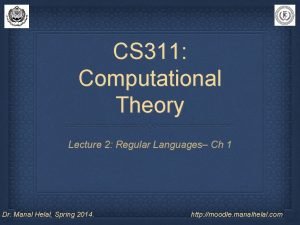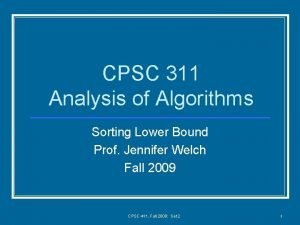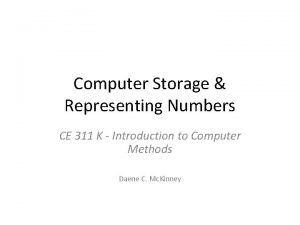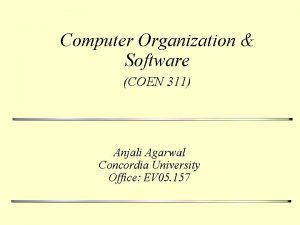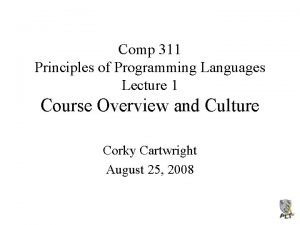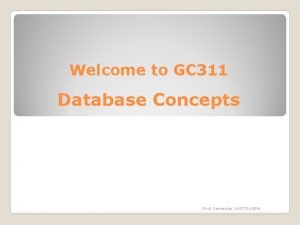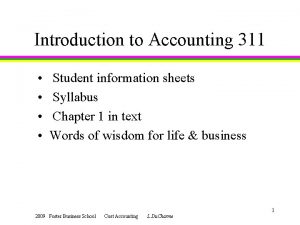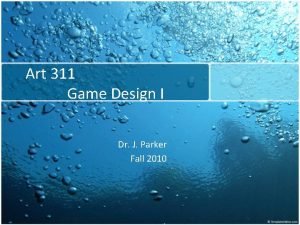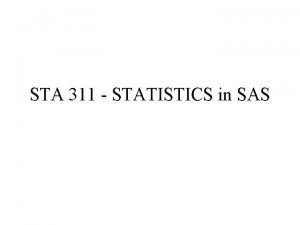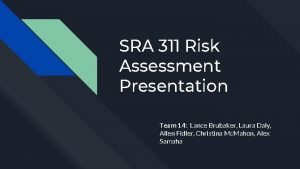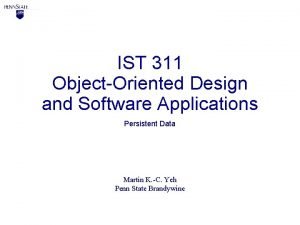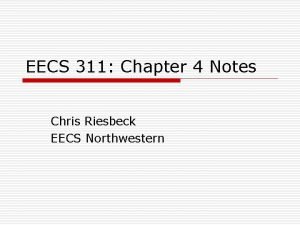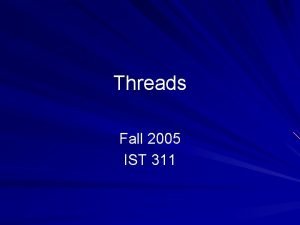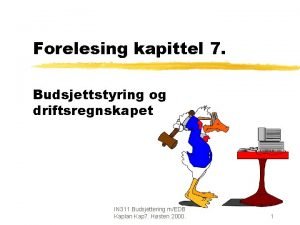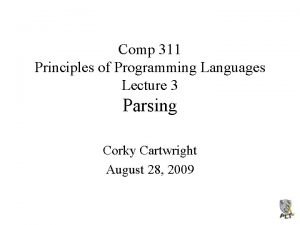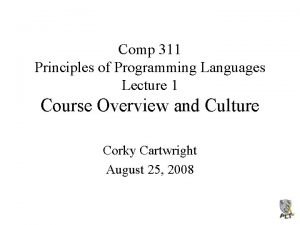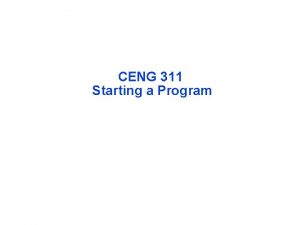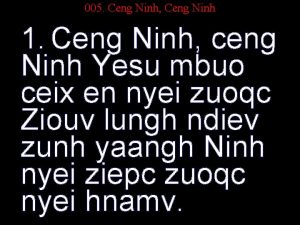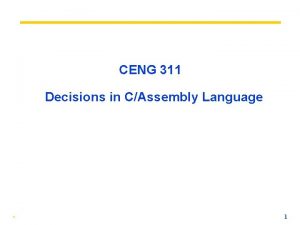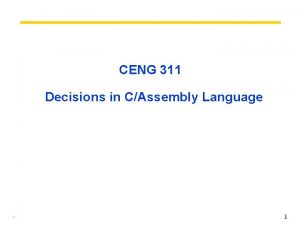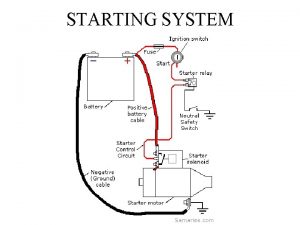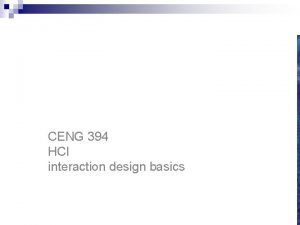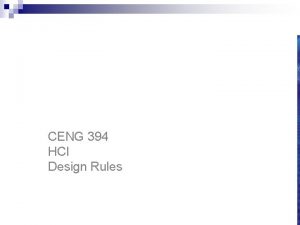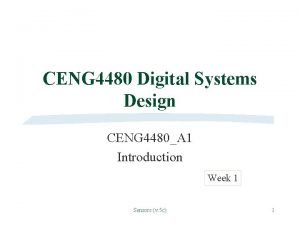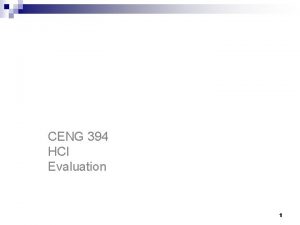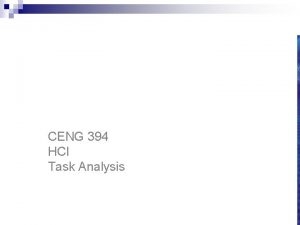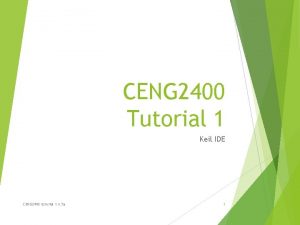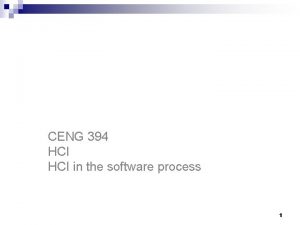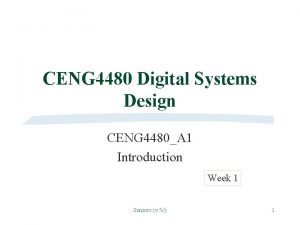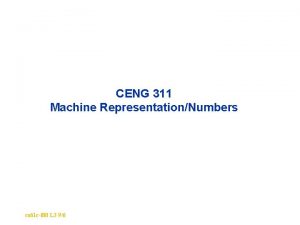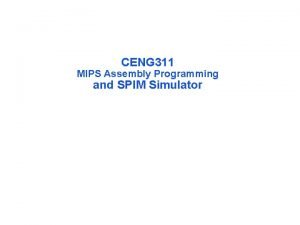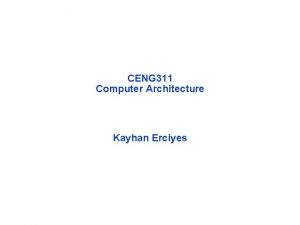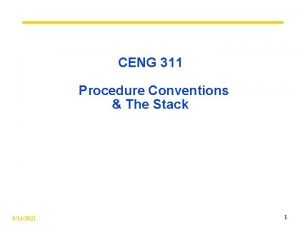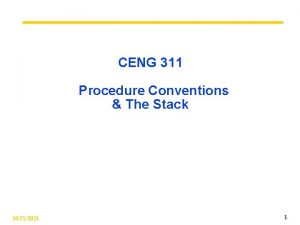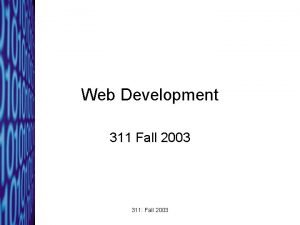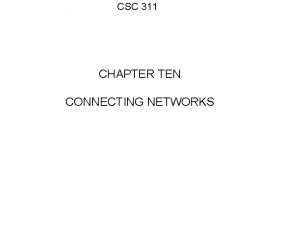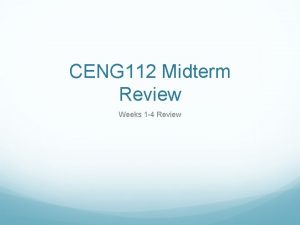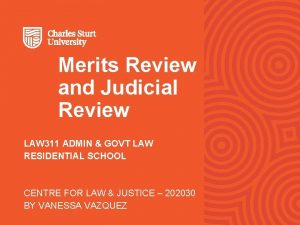CENG 311 Starting a Program Review 12 IEEE




































- Slides: 36

CENG 311 Starting a Program

Review (1/2) ° IEEE 754 Floating Point Standard: Kahan pack as much in as could get away with • +/- infinity, Not-a-Number (Nan), Denorms • 4 rounding modes ° Stored Program Concept: Both data and actual code (instructions) are stored in the same memory. ° Type is not associated with data, bits have no meaning unless given in context

Things to Remember (1/2) ° Machine Language Instruction: 32 bits representing a single MIPS instruction R opcode I opcode J opcode rs rs rt rd shamt funct rt immediate target address ° Instructions formats kept similar ° Branches, Jumps optimized for greater branch distance and hence strange ° New Logical, Shift Instructions: and, andi, ori, sll, sra

Outline ° Compiler ° Assembler ° Linker ° Loader ° Example

Steps to Starting a Program C program: foo. c Compiler Assembly program: foo. s Assembler Object(mach lang module): foo. o Linker lib. o Executable(mach lang pgm): a. out Loader Memory

Compiler ° Input: High-Level Language Code (e. g. , C, Java) ° Output: Assembly Language Code (e. g. , MIPS) ° Note: Output may contain pseudoinstructions ° Pseudoinstructions: instructions that assembler understands but not in machine (e. g. , HW#4); For example: ° mov $s 1, $s 2 = or $s 1, $s 2, $zero

Where Are We Now? C program: foo. c Compiler Assembly program: foo. s Assembler Object(mach lang module): foo. o Linker lib. o Executable(mach lang pgm): a. out Loader Memory

Assembler ° Reads and Uses Directives ° Replace Pseudoinstructions ° Produce Machine Language ° Creates Object File

Assembler Directives (p. A-51 to A-53) ° Give directions to assembler, but do not produce machine instructions. text: Subsequent items put in user text segment. data: Subsequent items put in user data segment. globl sym: declares sym global and can be referenced from other files. asciiz str: Store the string str in memory and null-terminate it. word w 1…wn: Store the n 32 -bit quantities in successive memory words

Pseudoinstruction Replacement ° Asm. treats convenient variations of machine language instructions as if real instructions Pseudo: Real: subu $sp, 32 addiu $sp, -32 sd $a 0, 32($sp) sw $a 1, 36($sp) mul $t 7, $t 6, $t 5 mflo $t 7 mul $t 6, $t 5 addu $t 0, $t 6, 1 addiu $t 0, $t 6, 1 ble $t 0, 100, loop slti $at, $t 0, 101 bne $at, $0, loop la $a 0, str lui $at, left(str) ori $a 0, $at, right(str)

Absolute Addresses in MIPS ° Which instructions need relocation editing? ° J-format: jump, jump and link j/jal xxxxx ° Loads and stores to variables in static area, relative to global pointer lw/sw $gp $x address ° What about conditional branches? beq/bne $rs $rt address ° PC-relative addressing preserved even if code moves

Producing Machine Language (1/2) ° Simple Case • Arithmetic, Logical, Shifts, and so on. • All necessary info is within the instruction already. ° What about Branches? • PC-Relative • So once pseudoinstructions are replaced by real ones, we know by how many instructions to branch. ° So these can be handled easily.

Producing Machine Language (2/2) ° What about jumps (j and jal)? • Jumps require absolute address. ° What about references to data? • la gets broken up into lui and ori • These will require the full 32 -bit address of the data. ° These can’t be determined yet, so we create two tables…

Symbol Table ° List of “items” in this file that may be used by other files. ° What are they? • Labels: function calling • Data: anything in the. data section; variables which may be accessed across files ° First Pass: record label-address pairs ° Second Pass: produce machine code • Result: can jump to a later label without first declaring it

Relocation Table ° List of “items” for which this file needs the address. ° What are they? • Any label jumped to: j or jal - internal - external (including lib files) • Any piece of data - such as the la instruction

Object File Format ° object file header: size and position of the other pieces of the object file ° text segment: the machine code ° data segment: binary representation of the data in the source file ° relocation information: identifies lines of code that need to be “handled” ° symbol table: list of this file’s labels and data that can be referenced ° debugging information

Where Are We Now? C program: foo. c Compiler Assembly program: foo. s Assembler Object(mach lang module): foo. o Linker lib. o Executable(mach lang pgm): a. out Loader Memory

Link Editor/Linker (1/2) ° What does it do? ° Combines several object (. o) files into a single executable (“linking”) ° Enable Separate Compilation of files • Changes to one file do not require recompilation of whole program - Windows NT source is >30 M lines of code! And Growing! • Called a module • Link Editor name from editing the “links” in jump and link instructions

Link Editor/Linker (2/2) ° Step 1: Take text segment from each. o file and put them together. ° Step 2: Take data segment from each. o file, put them together, and concatenate this onto end of text segments. ° Step 3: Resolve References • Go through Relocation Table and handle each entry • That is, fill in all absolute addresses

Four Types of Addresses ° PC-Relative Addressing (beq, bne): never relocate ° Absolute Address (j, jal): always relocate ° External Reference (usually jal): always relocate ° Data Reference (often lui and ori): always relocate

Resolving References (1/2) ° Linker assumes first word of first text segment is at address 0 x 0000. ° Linker knows: • length of each text and data segment • ordering of text and data segments ° Linker calculates: • absolute address of each label to be jumped to (internal or external) and each piece of data being referenced

Resolving References (2/2) ° To resolve references: • search for reference (data or label) in all symbol tables • if not found, search library files (for example, for printf) • once absolute address is determined, fill in the machine code appropriately ° Output of linker: executable file containing text and data (plus header)

Where Are We Now? C program: foo. c Compiler Assembly program: foo. s Assembler Object(mach lang module): foo. o Linker lib. o Executable(mach lang pgm): a. out Loader Memory

Loader (1/3) ° Executable files are stored on disk. ° When one is run, loader’s job is to load it into memory and start it running. ° In reality, loader is the operating system (OS) • loading is one of the OS tasks

Loader (2/3) ° So what does a loader do? ° Reads executable file’s header to determine size of text and data segments ° Creates new address space for program large enough to hold text and data segments, along with a stack segment ° Copies instructions and data from executable file into the new address space (this may be anywhere in memory)

Loader (3/3) ° Copies arguments passed to the program onto the stack ° Initializes machine registers • Most registers cleared, but stack pointer assigned address of 1 st free stack location ° Jumps to start-up routine that copies program’s arguments from stack to registers and sets the PC • If main routine returns, start-up routine terminates program with the exit system call

Example: C Asm Obj Exe Run #include <stdio. h> int main (int argc, char *argv[]) { int i; int sum = 0; for (i = 0; i <= 100; i = i + 1) sum = sum + i * i; printf ("The sum from 0. . 100 is %dn", sum); }

Example: C Asm Obj Exe Run. text. align 2. globl main: subu $sp, 32 sw $ra, 20($sp) sd $a 0, 32($sp) sw $0, 24($sp) sw $0, 28($sp) loop: lw $t 6, 28($sp) mul $t 7, $t 6 lw $t 8, 24($sp) addu $t 9, $t 8, $t 7 sw $t 9, 24($sp) addu $t 0, $t 6, 1 sw $t 0, 28($sp) ble $t 0, 100, loop la $a 0, str lw $a 1, 24($sp) jal printf move $v 0, $0 lw $ra, 20($sp) addiu $sp, 32 j $ra. data. align 0 str: . asciiz "The sum from 0. . 100 is %dn"

Symbol Table Entries ° Label Address main: loop: str: printf: ?

Example: C Asm Obj Exe Run • Remove pseudoinstructions, assign addresses 00 04 08 0 c 10 14 18 1 c 20 24 28 2 c addiu $29, -32 sw $31, 20($29) sw $4, 32($29) sw $5, 36($29) sw $0, 24($29) sw $0, 28($29) lw $14, 28($29) multu $14, $14 mflo $15 lw $24, 24($29) addu $25, $24, $15 sw $25, 24($29) 30 34 38 3 c 40 44 48 4 c 50 54 58 5 c addiu sw slti bne lui ori lw jal add lw addiu jr $8, $14, 1 $8, 28($29) $1, $8, 101 $1, $0, loop $4, l. str $4, r. str $5, 24($29) printf $2, $0 $31, 20($29) $29, 32 $31

Symbol Table Entries ° Symbol Table • Label Address main: 0 x 0000 loop: 0 x 00000018 str: 0 x 10000430 printf: 0 x 000003 b 0 ° Relocation Information • Address • 0 x 0000004 c Instr. Type. Dependency jal printf

Example: C Asm Obj Exe Run • Edit Addresses: start at 0 x 0040000 00 addiu $29, -32 30 addiu $8, $14, 1 04 sw $31, 20($29) 34 sw $8, 28($29) 08 sw $4, 32($29) 38 slti $1, $8, 101 0 c sw $5, 36($29) 3 c bne $1, $0, -10 10 sw $0, 24($29) 40 lui $4, 4096 14 sw $0, 28($29) 44 ori $4, 1072 18 lw $14, 28($29) 48 lw $5, 24($29) 1 c multu $14, $14 4 c jal 812 20 mflo $15 50 add $2, $0 24 lw $24, 24($29) 54 lw $31, 20($29) 28 addu $25, $24, $15 58 addiu $29, 32 2 c sw $25, 24($29) 5 c jr $31

Example: C Asm Obj Exe Run 0 x 004000 0 x 004004 0 x 004008 0 x 00400 c 0 x 004010 0 x 004014 0 x 004018 0 x 00401 c 0 x 004020 0 x 004024 0 x 004028 0 x 00402 c 0 x 004030 0 x 004034 0 x 004038 0 x 00403 c 0 x 004040 0 x 004044 0 x 004048 0 x 00404 c 0 x 004050 0 x 004054 0 x 004058 0 x 00405 c 001001111011111100000 101011111100000010100 10101111101001000000100000 10101111101000000100100 101011111010000000011000 101011111010000000011100 10001111101011100000011100 1000111110000000011000 000000011100000011001 00100101110010000000001 001010010000000001100101 1010111110101000000011100 000000000111100000010010 0000001111110010000101000001111110111 10101111100100000011000 00111100000001000000 1000111110100000001100000000000011101100 0010010010000000110000 100011111100000010100 00100111101000001000000111110000000001000 000000000010000001

Things to Remember (1/3) C program: foo. c Compiler Assembly program: foo. s Assembler Object(mach lang module): foo. o Linker lib. o Executable(mach lang pgm): a. out Loader Memory

Things to Remember (2/3) ° Compiler converts a single HLL file into a single assembly language file. ° Assembler removes pseudos, converts what it can to machine language, and creates a checklist for the linker (relocation table). This changes each. s file into a. o file. ° Linker combines several. o files and resolves absolute addresses. ° Loader loads executable into memory and begins execution.

Things to Remember 3/3 ° Stored Program concept mean instructions just like data, so can take data from storage, and keep transforming it until load registers and jump to routine to begin execution • Compiler Assembler Linker ( Loader ) ° Assembler does 2 passes to resolve addresses, handling internal forward references ° Linker enables separate compilation, libraries that need not be compiled, and resolves remaining addresses
 Ieee engineering management review
Ieee engineering management review Ieee fellow program
Ieee fellow program Uw cse 312
Uw cse 312 Art 294 a 311 cpc
Art 294 a 311 cpc Contoh knapsack problem
Contoh knapsack problem College of information sciences and technology
College of information sciences and technology 467 to the nearest 100
467 to the nearest 100 Psyc 311
Psyc 311 Rtca do-347
Rtca do-347 Rpv 311
Rpv 311 Coen 311
Coen 311 Chinese remainder theorem
Chinese remainder theorem The number 311-38 is divisible by prime numbers:
The number 311-38 is divisible by prime numbers: Ssis 311
Ssis 311 Eecs 311
Eecs 311 Cs 311
Cs 311 A2yes
A2yes 311 k
311 k Coen 311 concordia
Coen 311 concordia Comp 311 textbook notes
Comp 311 textbook notes Gc 311
Gc 311 Accounting 311
Accounting 311 J parker designs
J parker designs 311
311 Psyc 311 study guide
Psyc 311 study guide Sta 311
Sta 311 Lance brubaker
Lance brubaker Was ist rdbms
Was ist rdbms Chris riesbeck
Chris riesbeck Ist 311
Ist 311 Suprasil 311
Suprasil 311 In 311
In 311 Exchange server demo
Exchange server demo Sfu educ 311
Sfu educ 311 ?3305501049 0000 28|.|091 27|.|071 98|.|553 102|.|311 13`
?3305501049 0000 28|.|091 27|.|071 98|.|553 102|.|311 13` Comp 311 textbook notes
Comp 311 textbook notes Comp 311 study guide
Comp 311 study guide

